Solar System: 10 Things To Know This Week
Solar System: 10 Things to Know This Week
State of the Solar System: 10 quick updates from around our galactic neighborhood.
1. Powered by the Sun

Fifty-nine years ago, Vanguard 1 launched to demonstrate a new spacecraft technology – solar power. We’ve been going farther and for longer ever since.
+More on Vanguard 1
2. Mapping Mercury

A big week in history for exploration of the innermost planet. On March 16, 1975, our Mariner 10 made its third and final flyby of Mercury. One day and 36 years later, MESSENGER became the first spacecraft to orbit Mercury. Next up: ESA’s BepiColumbo, undergoing testing now, is set to launch for Mercury in 2018.
+Missions to Mercury
3. Return to Venus

U.S. and Russian scientists are discussing a planned revival of the successful Venera program that revealed much about Venus in the 1960s, 70s and 80s. Meanwhile, Japan’s Akatsuki orbiter continues to study our sister planet.
+More on Venera-D
4. Rocket Power

Back on Earth 91 years ago (March 16, 1926), inventor and dreamer Robet Goddard changed the world forever with the first test of a liquid-fueled rocket. We’ve been going farther and faster ever since.
+More on Goddard
5. Moon Watch

Our Lunar Reconnaissance Orbiter (LRO) has been sending a steady stream of high-resolution images back to Earth for more than seven years.
+More on LRO
6. Busy Mars

There are currently five orbiters (Mars Reconnaissance Orbiter, Mars Odyssey, MAVEN, ESA’s Mars Express and India’s Mars Orbiter Mission) and two rovers (Curiosity and Opportunity) exploring Mars, making it second only to Earth in the number of robotic spacecraft studying its secrets.
+Meet the Mars Fleet
7. Vote for Jupiter

Polls close today (March 20) so vote not to point a real spacecraft camera at Jupiter during the mission’s 5th perijove pass.
+Vote now
8. Science to the Last Second

In a little less than six months, our Cassini orbiter will plunge into Saturn as a spectacular finale to its 19-year mission – but not before it embarks on a completely new mission into unexplored space between Saturn and its mighty rings.
+More on Cassini’s Grand Finale
9. By George?

Happy belated birthday to Uranus, discovered on March 13, 1781 by William Herschel. The English astronomer wanted to name his discovery – the first planet discovered in recorded history – “Georgium Sidus” after England’s King George III. But he was overruled, and astronomer stuck with traditional mythological names – creating an opportunity for 263 years of student jokes at the expense of the ice giant planet’s name.
+More on Uranus
10. Go Farther

The round trip light time from Voyager 1 to Earth is more than 38 hours. Voyager 1 is almost 13 billion miles from our home planet.
+More on Voyager
Discover more lists of 10 things to know about our solar system HERE.
Make sure to follow us on Tumblr for your regular dose of space: http://nasa.tumblr.com
More Posts from Astrotidbits-blog and Others

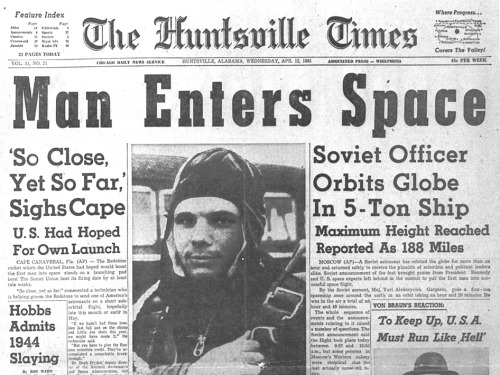


April 12th 1961: Yuri Gagarin becomes the first man in space
On this day in 1961, the Russian cosmonaut Yuri Gagarin became the first human to travel into outer space. Gagarin, a fighter pilot, was the successful candidate for the mission, being selected by Russian space programme director Sergei Korolev. Russia already had a lead in the Space Race, having launched Sputnik 1 in 1957, which was the first satellite in space. On April 12th 1961, Gagarin left Earth aboard the Vostok 1 spacecraft, famously declaring ‘Poyekhali!’ (which means ‘Let’s go!’ in Russian). He spent 108 minutes completing an orbit of the planet. Upon re-entering the atmosphere, Gagarin executed a successful ejection and landed by parachute in rural Russia, to the consternation of locals. Yuri Gagarin became famous worldwide and a Russian hero, being awarded the nation’s highest honour - Hero of the Soviet Union. Gagarin died in 1968 when the training plane he was piloting crashed; his ashes were buried in the walls of the Kremlin.
“Don’t be afraid, I am a Soviet citizen like you, who has descended from space and I must find a telephone to call Moscow!” - Gagarin to some stunned farmers when he landed
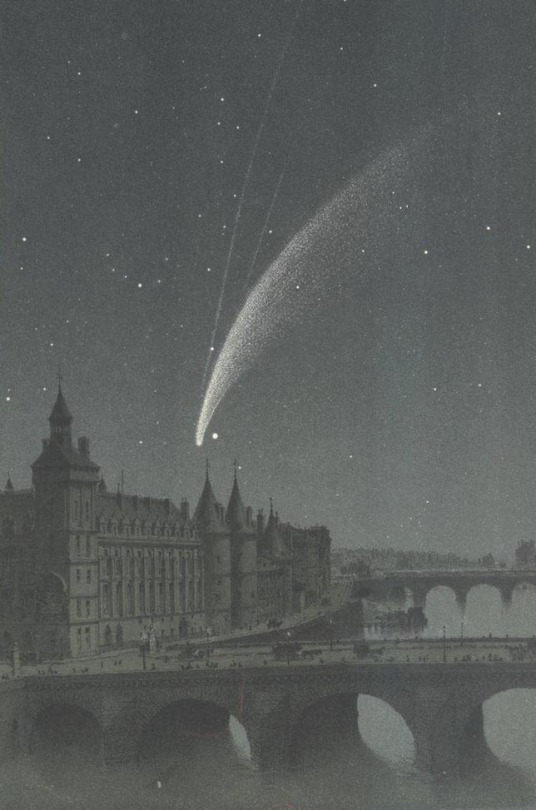
Amédée Guillemin, Les comètes (1875)
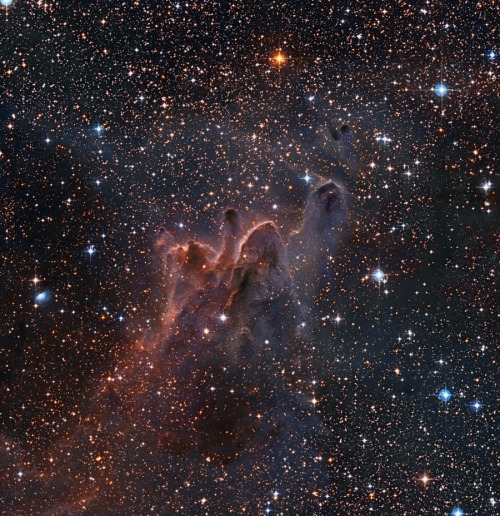
Cometary Globules
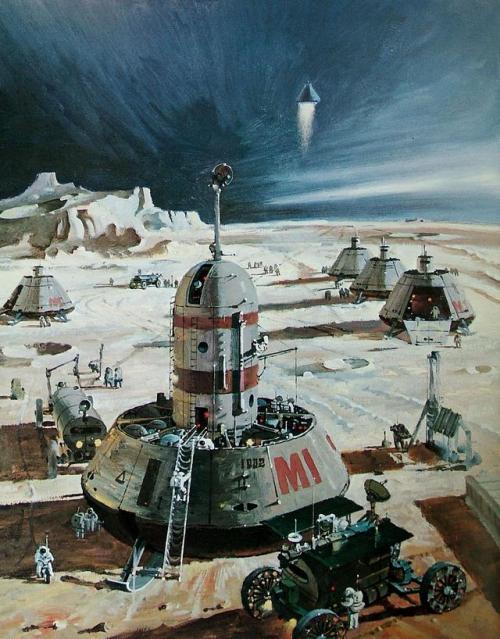
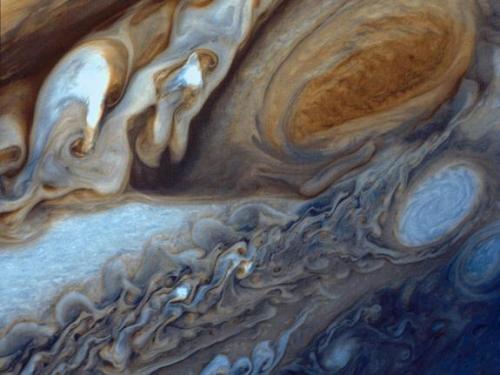
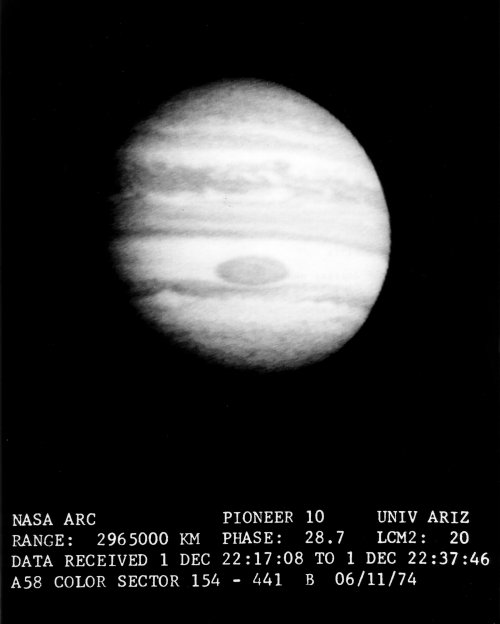
This view of Jupiter shows the giant planet’s cloud tops taken by the Pioneer 10 spacecraft as it flew past Jupiter. This view was taken from 2,695,000 kilometers (1,842,451 miles) away. It shows the 25,000 mile long Great Red Spot, which is large enough to swallow up several Earths. Individual cloud formations are visible in some detail. The bright zones appear to become split up into the detailed flow patterns of Jupiter’s atmosphere and clouds. The area surrounding the Spot in the bright South Tropical Zone, suggests a flow pattern about the Spot which is bulged toward the north by the Spot. The Spot may be a gigantic “permanent hurricane.” The gigantic cloud swirls are thousands or more miles across. Pioneer 10 flew past Jupiter in December 1974 and flew past the orbit of Pluto in 1987. A sister spacecraft, Pioneer 11 reached Jupiter in December 1975. The Pioneer Project was managed by NASA’s Ames Research Center, Mountain View, Calafornia. The spacecraft was built by TRW Systems.
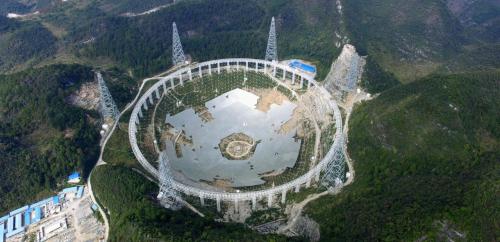

China’s giant alien-hunting telescope is ready
Our alien-hunting game just got a lot stronger with the completion of a huge radio telescope in the Guizhou province of China. It’s called the Five-hundred-meter Aperture Spherical Telescope (FAST), and it’s designed to listen for signs of alien life out in the cosmos. The telescope is finished, but the construction was not without human rights controversy.
Follow @the-future-now
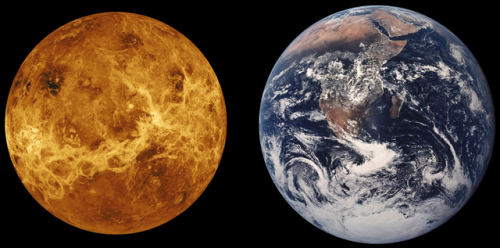
The second closest planet to the sun, Venus. Venus is about the same size as Earth, having a 12,104 km diameter. Venus has phases, like our moon, that can be seen as a crescent to a full circle. When visible at dusk and dawn, Venus is the brightest shining object in the sky (besides the sun & moon of course), brighter than mercury and mars. It is the hottest planet, and it’s surface temperature can reach up to 470 degrees Celsius. This is because Venus traps the sun’s heat, unlike mercury which doesn’t. A day on Venus lasts longer than its year, lasting for 19 days over. Venus is definitely a planet we could explore more, we just need to find a way to combat the blistering heat! ☀️
I'm curious about the physics of bottle rockets. In the novel I'm writing, my characters use bottle rockets as weapons. They tape sharpened sticks to the rockets and use them as projectile spears. What would be the velocity of a bottle rocket with a stick taped to it? What kind of damage would it inflict? Love your blog! Thank you!
The final velocity depends on a lot of variables, like the trajectory, weight, fuel being used, burn rate of the fuel, size of the bottle, etc. However, you can be assured that they can be harmful and with the right pointy sticks, they can be deadly.
Here’s one example:
Good luck with your novel!
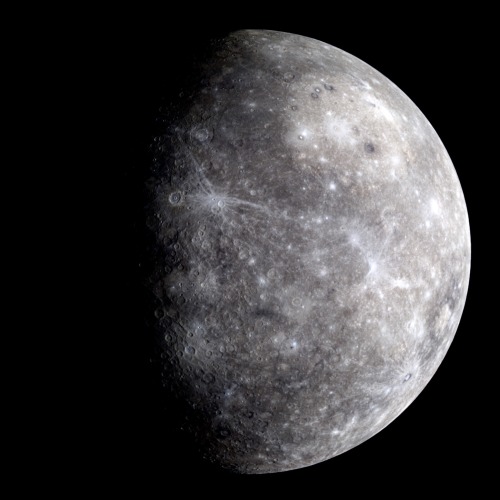
New day, new series of photos. I’m going to try to blog about the planets of the Solar System; First up is Mercury, which is the smallest and innermost planet. With a diameter ~4878km, it is smaller than some of the moons in the Solar System. The small planet in a 3:2 resonance with the sun, giving it a unique position where a single day takes 2 Mercurian years. It has the smallest tilt of any planet in the Solar System at just 1/30 of a degree.
Keep reading
-
 randofriendo reblogged this · 4 years ago
randofriendo reblogged this · 4 years ago -
 randofriendo liked this · 4 years ago
randofriendo liked this · 4 years ago -
 cozy-queen-of-hats liked this · 4 years ago
cozy-queen-of-hats liked this · 4 years ago -
 localdeadgirl1999 liked this · 4 years ago
localdeadgirl1999 liked this · 4 years ago -
 theroyaltreasury liked this · 5 years ago
theroyaltreasury liked this · 5 years ago -
 ensaturne liked this · 5 years ago
ensaturne liked this · 5 years ago -
 somefishdood liked this · 5 years ago
somefishdood liked this · 5 years ago -
 radiumkind liked this · 5 years ago
radiumkind liked this · 5 years ago -
 ungodlyvirtue liked this · 6 years ago
ungodlyvirtue liked this · 6 years ago -
 huebinator liked this · 6 years ago
huebinator liked this · 6 years ago -
 blehhhhsheetpose-blog liked this · 7 years ago
blehhhhsheetpose-blog liked this · 7 years ago -
 stahhhhpppp liked this · 7 years ago
stahhhhpppp liked this · 7 years ago -
 not0a0mundane liked this · 7 years ago
not0a0mundane liked this · 7 years ago -
 llovecrossover16-blog liked this · 7 years ago
llovecrossover16-blog liked this · 7 years ago -
 lietheiden liked this · 7 years ago
lietheiden liked this · 7 years ago -
 thatkidblevz liked this · 7 years ago
thatkidblevz liked this · 7 years ago -
 shywizardballoon liked this · 7 years ago
shywizardballoon liked this · 7 years ago -
 ds103 liked this · 7 years ago
ds103 liked this · 7 years ago -
 essayguard-blog reblogged this · 7 years ago
essayguard-blog reblogged this · 7 years ago -
 myzwxchu liked this · 7 years ago
myzwxchu liked this · 7 years ago -
 2charmz liked this · 7 years ago
2charmz liked this · 7 years ago -
 essayguard-blog liked this · 7 years ago
essayguard-blog liked this · 7 years ago -
 jessicawestrick-blog liked this · 7 years ago
jessicawestrick-blog liked this · 7 years ago -
 zaytruthx reblogged this · 7 years ago
zaytruthx reblogged this · 7 years ago -
 sassierrr liked this · 7 years ago
sassierrr liked this · 7 years ago -
 wesadposts reblogged this · 7 years ago
wesadposts reblogged this · 7 years ago -
 lelaylei liked this · 7 years ago
lelaylei liked this · 7 years ago -
 konst65 liked this · 8 years ago
konst65 liked this · 8 years ago -
 seggxy liked this · 8 years ago
seggxy liked this · 8 years ago -
 geilene-blog liked this · 8 years ago
geilene-blog liked this · 8 years ago -
 algid-star reblogged this · 8 years ago
algid-star reblogged this · 8 years ago -
 rainbow-butt-monkeys liked this · 8 years ago
rainbow-butt-monkeys liked this · 8 years ago -
 sarahchachaaa reblogged this · 8 years ago
sarahchachaaa reblogged this · 8 years ago -
 utot-atbp liked this · 8 years ago
utot-atbp liked this · 8 years ago